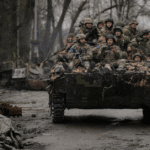Scientists Warn: Massive Earthquake is Coming? The Great Himalayan Earthquake
The Himalayas—home to the world’s tallest peaks, spiritual sanctuaries, and millions of people—are sitting on a ticking time bomb. Recent studies suggest a catastrophic earthquake, possibly exceeding magnitude 8.5, could strike the region. But how real is this threat? Let’s break it down.
What Is the Great Himalayan Earthquake Threat?
Let’s get straight to the point—this isn’t just another sci-fi Netflix plot. Scientists are shouting from every rooftop they can find: a devastating earthquake is not just possible, it’s highly likely. And not in a distant-future kind of way. We’re talking in the “could happen in our lifetime” range.
The “Great Himalayan Earthquake” refers to a long-anticipated seismic disaster along the Himalayan belt—one of the most seismically volatile zones in the world. We’re sitting on a time bomb, and the fuse is smoldering.
What’s Brewing Beneath the Himalayas?
The Indian tectonic plate is slowly but relentlessly pushing under the Eurasian plate at a rate of about 2 inches per year. This collision created the Himalayas—and it’s still ongoing. The friction builds up stress, and when it finally releases—BAM—we get a megaquake.
Key Facts:
Potential Magnitude: 8.5 to 9.0 (some experts even speculate a 10.0, though rare).
Affected Regions: Northern India, Nepal, Bhutan, Bangladesh, and parts of China.
Last Major Quake: 2015 Nepal earthquake (7.8 magnitude)—killed nearly 9,000 people.
Key Warnings From Scientists—Why Now?
The video, backed by research from geologists like Dr. Roger Bilham, screams one thing: we are overdue. The last time a major quake ripped through the Central Himalayan region, Elvis was probably still alive. Since then, the tension beneath the crust hasn’t just chilled—it’s multiplied.
How overdue are we? Some scientists say we’ve exceeded the safe margin by 200-300 years. Let that sink in.
Why Are Scientists So Alarmed?
The “Seismic Gap” Theory
Some sections of the Himalayan fault haven’t ruptured in over 500 years. That’s a big problem. When stress isn’t released gradually through small quakes, it accumulates—leading to a “big one.”
Quotes from Experts:
“The Himalayas are overdue for a major earthquake. The question isn’t if, but when.” — Dr. Roger Bilham, Geologist.
*”A magnitude 8.5+ quake could displace millions and cause unprecedented destruction.”* — Prof. Vinod K. Gaur, Geophysicist.
The Science Behind It—Explained Simply
Let’s break down the jargon.
The Indian Plate is playing WWE with the Eurasian Plate.
They’re locked in a smackdown that’s been going on for 50 million years.
All this pushing causes stress to build up in the Earth’s crust.
When the stress breaks—BOOM—that’s your earthquake.
A “megathrust” earthquake means the ground literally lurches upward, potentially for hundreds of kilometers. Think of a zipline getting yanked tight and then snapped. Except you’re standing on it.
Historical Earthquakes in the Himalayas
The Himalayan belt has a bloody resume:
1905 Kangra Earthquake: ~20,000 deaths.
1934 Bihar–Nepal Quake: Over 10,000 deaths.
2005 Kashmir Earthquake: Around 86,000 people killed.
2015 Nepal Earthquake: Claimed nearly 9,000 lives.
These weren’t even the big one.

What’s Different This Time Around?
Back then? Sparse population. Weak infrastructure.
Now? Urban sprawl. High-rises. Data centers. Flyovers.
And let’s not forget: bad construction practices and illegal building permits could kill more people than the quake itself.
Satellites and simulations now show just how massive this next rupture could be—affecting a 700 km stretch in one go.
The Human Cost: Why This Earthquake Could Be Catastrophic
Imagine this: A magnitude 8.5 earthquake hits the Himalayas at midnight. Entire villages vanish under landslides. Cities like Kathmandu—packed with poorly constructed buildings—collapse in seconds. Hospitals overflow, roads are impassable, and survivors fight for food and water. This isn’t a dystopian movie plot—it’s a realistic scenario based on scientific models.
The 2015 Nepal quake was just a preview. A bigger one could kill ten times more people, especially in rural areas where rescue teams take days to arrive. The real tragedy? Many deaths could be prevented with better infrastructure and preparedness—but politics and poverty keep getting in the way.
The Science Behind the Doomsday Prediction
Here’s what keeps seismologists awake at night: The Main Himalayan Thrust, a massive fault line, is locked and loading stress like a coiled spring. GPS data shows the Indian plate shoving northward, but the surface isn’t moving—meaning all that energy is building up underground.
When it finally snaps, the rupture could span 600 miles, unleashing energy equivalent to thousands of nuclear bombs. The scariest part? Historical records suggest these megaquakes happen every 500–1,000 years, and the last one was in 1505. We’re overdue.
How Climate Change Makes Everything Worse
Melting glaciers add a terrifying twist to this disaster-in-waiting. Quake-triggered landslides could dam rivers, creating temporary lakes that burst and flood valleys. Permafrost thaw destabilizes slopes, making remote roads—lifelines for aid—unusable. Even worse? Monsoon rains could turn rubble into sludge, trapping survivors.
Meanwhile, rising temperatures push farmers higher into unstable hills, putting more people in harm’s way. It’s a perfect storm of natural and man-made risks, and the Himalayas are ground zero.
The Ripple Effect: Global Consequences
This isn’t just a regional crisis. A Himalayan megaquake could stagger the world economy. Supply chains for electronics, textiles, and pharmaceuticals—all reliant on South Asian factories—would snap. Tourism (think Everest expeditions) would collapse overnight. Mass migration could spark border conflicts, especially between India and China.
And let’s not forget the psychological toll: Watching ancient temples and UNESCO sites crumble would be a gut punch to humanity’s shared heritage. The aftershocks—literal and metaphorical—would echo for decades.
What You Can Do Right Now
Panicking won’t help, but action will. If you live in the region: Reinforce your home (even simple fixes like securing shelves save lives), pack a go-bag (water, meds, cash), and learn CPR. Everyone else: Donate to orgs training local responders (like this one) and pressure leaders to fund early-warning systems. Knowledge is power—share this article. The more people prepare, the fewer will die when—not if—the earth shakes.
How Bad Could It Get?
Worst-Case Scenario:
Casualties: 100,000+ (due to densely populated cities like Kathmandu).
Economic Loss: $100+ billion (rebuilding costs, trade disruption).
Secondary Disasters: Landslides, floods from dam breaches, disease outbreaks.
Are We Prepared?
Short answer: No.
Nepal & India: Building codes exist but are poorly enforced.
Remote Areas: Villages lack emergency response systems.
Possible Impacts—What Happens If It Hits Tomorrow?
Scared yet? Here’s what we might face:
Casualties: Over 1 million people at risk.
Buildings: Pancaked. Even some new ones.
Transport: Roads, bridges, rails—gone.
Power & Water: No electricity. No running water. Chaos.
International rescue teams may not even be able to reach us in time.
What’s Being Done?
Early Warning Systems
Countries are investing in seismic sensors, but coverage is spotty. Japan’s system gives 10-30 seconds of warning—enough to shut down trains or factories. The Himalayas? Maybe 5-10 seconds—if you’re lucky.
Community Preparedness
NGOs are training locals in first aid and evacuation drills. But with millions at risk, it’s a drop in the ocean.
Why People Are Still Ignoring the Warnings
It’s the classic case of “It won’t happen to me.”
People are used to hearing bad news—and after COVID, floods, and elections—this one just feels like another “meh” headline. But this one could be different. Like, life-altering different.

What You Can Do Now to Stay Safe
Here’s a survival starter pack:
Emergency kit (water, meds, flashlight, charger, whistle)
Learn the triangle of life
Secure heavy furniture at home
Practice mock drills with family
Use earthquake alert apps like MyShake
The Psychological Toll—Living Under a Constant Threat
Living with “it could strike any second” can take a toll.
Kids develop quake anxiety. Adults push it down till it leaks out in panic. PTSD post-quake is common.
Start conversations. Seek help. Know you’re not alone.
Future Implications
Climate Change Complicates Things
Melting glaciers increase landslide risks post-quake. More people are migrating to cities—often into informal, unsafe housing.
Could This Change Global Politics?
China-India Tensions: Disaster diplomacy or territorial disputes over relief efforts?
Refugee Crisis: Millions may flee, straining neighboring countries.
FAQs: What People Are Asking
Is a magnitude 10.0 earthquake possible?
Extremely rare, but not impossible. The largest recorded was 9.5 (Chile, 1960).When will the next big Himalayan quake hit?
No exact date—could be tomorrow or in 50 years. But stress is building.Which cities are most at risk?
Kathmandu, Dhaka, Dehradun, Thimphu.Can we predict earthquakes?
Not yet. Early warnings give seconds, not days.How can I prepare?
Stock food, water, first aid. Know evacuation routes.Will skyscrapers in Delhi collapse?
Older buildings might. Newer ones should withstand tremors—if built right.Could this trigger a tsunami?
Unlikely—it’s not an oceanic plate boundary.What’s the “Big One” scientists keep mentioning?
A hypothetical megaquake that could kill millions.Are animals able to sense earthquakes early?
Anecdotal evidence says yes, but no scientific consensus.How does this compare to the 2004 Indian Ocean quake?
That was a 9.1—tsunami killed 230,000. A Himalayan quake could rival that death toll.Is Nepal doing anything to prepare?
Yes, but funding and enforcement are huge challenges.Could this affect Mount Everest?
Yes—avalanches, route collapses. Climbers would be stranded.Would international aid help?
Yes, but politics may slow response times.Are there any positive outcomes?
Better infrastructure after the disaster—if governments learn.Where can I track real-time seismic activity?
USGS and Indian Meteorological Department websites.
Final Thoughts
The Himalayas are a disaster waiting to happen. The science is clear—a massive earthquake is coming. The only unknowns are when and how bad. Preparation is key, but time might be running out.
To Stay Prepared and Learn More, Visit Gemscor.com














